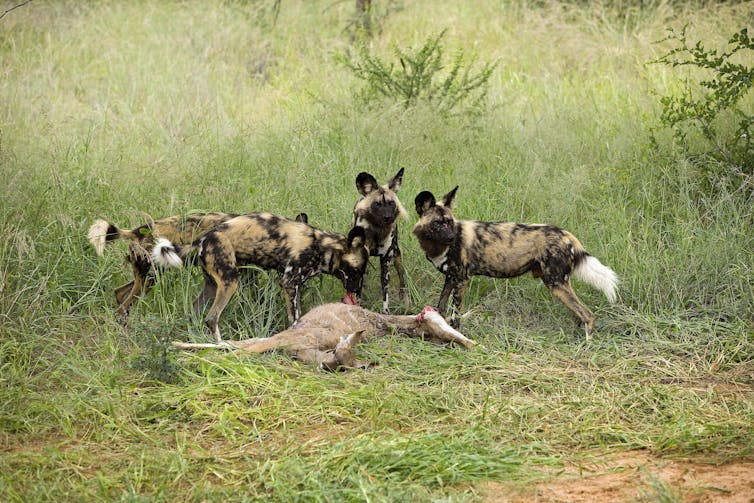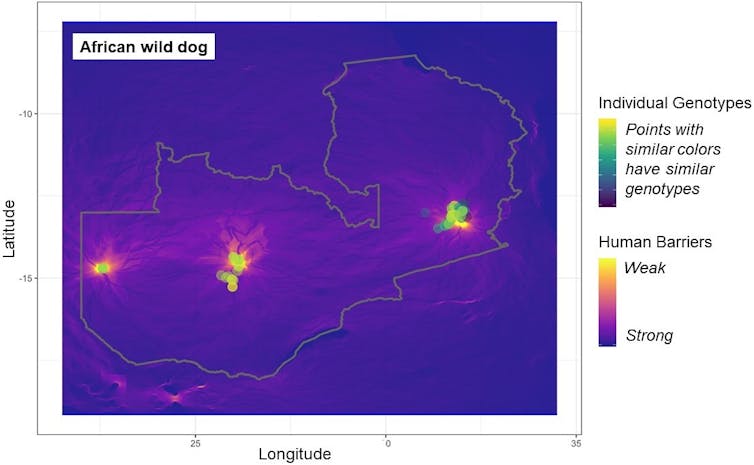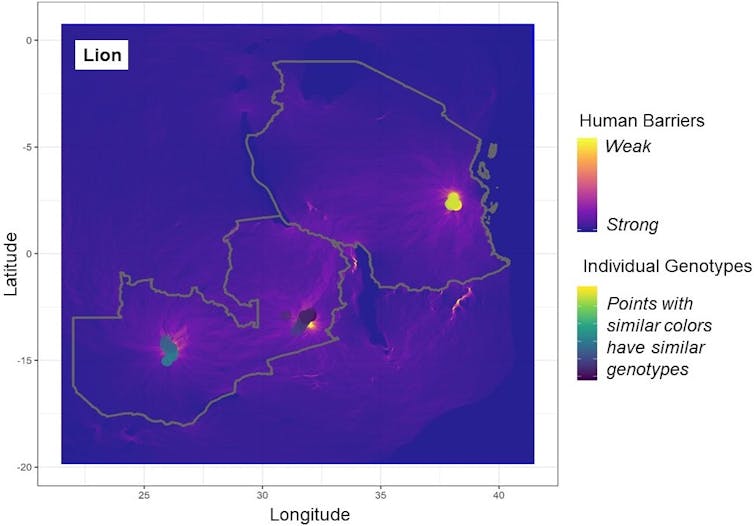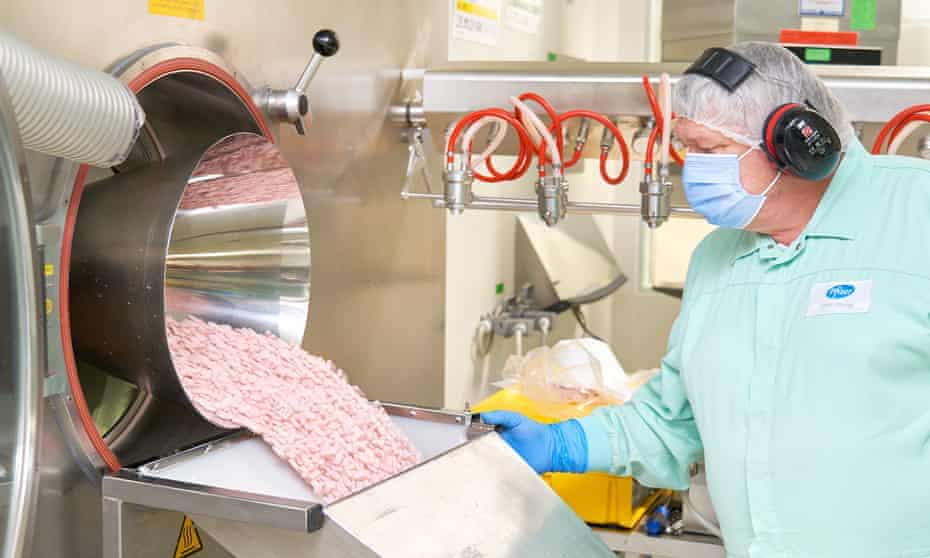Messy mining practices make for much work

Faro mine site showing water-filled pit, waste rock and tailings.
(screen shot from Parsons Inc. website)
LAWRIE CRAWFORD, LOCAL JOURNALISM INITIATIVE REPORTER
Feb. 19, 2022
Over a quarter of a century after the last rock truck wound its way out of the Faro mine pit, it appears a long-sought route to remediation is underway. On February 15, Canada signed a $108 million contract with Parsons Inc. for construction management and two years of care and maintenance on the Faro mine site.
Parsons, one of the largest players in remediation in the world, boasts that their “contract could span over 20 years and exceed $2 billion.”
The numbers boggle the mind, says Lewis Rifkind of the Yukon Conservation Society. Afterall, $2.2 billion is the total 15-year federal allocation for the northern abandoned mines program designed for eight mines in the Yukon and Northwest Territories. Faro is just one, and the federal contract does not include the Vangorda plateau portion of the Faro site, which was sold separately for future and concurrent, development and reclamation.
But still, the numbers keep going up, and the timeline keeps getting extended. Five years ago, the costs were anticipated at $500 million for 10-15 years, and now estimates are for $2 billion over twenty years.
In addition to the contract awarded to Parsons this week, another contract for $5.8 million was awarded to another company, CH2M Hill Canada Ltd., to design a water treatment plant for the site. According to Treasury Board data, these two contracts are in addition to the total federal spend on the Faro mine site between 2006 to 2021, which amounts to over $600 million.
Geology drove the creation of the mine, and drives the clean-up. The tailings, which cover an area equivalent to over 26,000 football fields, creates acid-rock drainage, which, if not mitigated, grows worse over time. There are an estimated 70 million tonnes of tailings and 320 million tonnes of waste rocks on the Faro site.
Once billed as the largest open pit lead-zinc mine in the world, the story of Faro is not a straight, nor smooth line. Faro is a story of zealot prospectors, ambitious and visionary collaborators, and an assortment of wheelers and dealers, aided and abetted by eager politicians.
They waived a mine and a town into existence essentially in the middle of nowhere, and convinced authorities to build a new hydro dam and improve highways; and for banks and governments to open their wallets with an assortment of loans, loan guarantees and grants — sometimes referred to as “other people’s money”. A book of the same name documents the rise and fall of one of the Faro mine owners, Dome Petroleum.
Faro’s height of prosperity in the late 1970’s was under Dome’s tenure and boasted the highest standard of living for the community’s 2,500 people. Labourers were paid $25 per hour and the cafeteria served steak and lobster. Those were the heady days of Dome Petroleum.
But Dome’s dealings paled compared to those during the tenure of Curragh Resources under Clifford Frame with his cut-throat, anything-to-save-a-buck approach to mining, that ended with the death of 26 miners at his Westray mine, that also ended his Faro venture.
Between closures and shut downs, Faro produced ore for around 22 of the 28 years between 1970 and 1998. Community comfort rose and fell with the price of ore. The townsite was carefully planned but burned to the ground in a forest fire in 1968, one year after completion. The town was rebuilt with tiers of stratified housing according to rank (executives on the upper bank) and bunkhouses on the lower bench. It was carefully located distant from Ross River, and kept most of its First Nation employees working in the coal mine adjacent to Carmacks.
Faro’s legacy is Yukon-wide. It created the demand for the Aishihik hydro dam which left the territory with excess hydro capacity for decades, opened the south Klondike highway year-round, left a viable townsite with affordable housing supported by a municipal grant which has left structures in place to house care and maintenance workers into the future.
But the colonial arrogance of the day is much more apparent now than then. The federal government asserts that remediation and restoration of the land is part of reconciliation efforts with First Nations. Submissions from the Liard First Nation to Yukon Environmental and Socio-economic Board show that they are not fully convinced that the standards set for remediation are high enough.
Parsons is now managing two of the world’s largest mine closure and reclamation projects, the Giant Mine in Northwest Territories, and now the Faro Mine Remediation Project, both of which rank in the top five on Canada’s most contaminated sites list.
Rifkind says that without mining there would be no reclamation industry, likening it to an altered form of Naomi Klien’s concept of disaster capitalism — companies that specialize in doing massive environmental cleanup after massive mining operations leave a mess.
That said, and apart from the enormous amount of greenhouse gas emissions that will be released as part of this project, and ignoring the amount of lime that will be required, Rifkind says that Parsons would be his choice of company to undertake the project as well.
“We’re thankful that something is actually happening. At least they are doing something” he says.
And for First Nations, the reclamation pill is harder to swallow. Never settled and never ceded, the Liard First Nation and the Ross River Dene Council have witnessed the slow and cumulative destruction of animal habitat, and the erosion of their wilderness of clean rivers and lakes.
“The legacy of harm is both physical and emotional,” said Chief Jack Caesar of the Ross River Dena Council. In a statement he said that “Canada’s sincere efforts to support a remediation process that includes our community is a major step towards improving both the land and our peoples’ experience around the Faro Mine.”
Rifkind calls it a “big environmental boondoggle.” All this, stemming from the dreams of a couple of persistent prospectors in the 1960s and 1970s: both died tragically in 1977.
Contact Lawrie Crawford at lawrie.crawford@yukon-news.com
LAWRIE CRAWFORD, LOCAL JOURNALISM INITIATIVE REPORTER
Feb. 19, 2022
Over a quarter of a century after the last rock truck wound its way out of the Faro mine pit, it appears a long-sought route to remediation is underway. On February 15, Canada signed a $108 million contract with Parsons Inc. for construction management and two years of care and maintenance on the Faro mine site.
Parsons, one of the largest players in remediation in the world, boasts that their “contract could span over 20 years and exceed $2 billion.”
The numbers boggle the mind, says Lewis Rifkind of the Yukon Conservation Society. Afterall, $2.2 billion is the total 15-year federal allocation for the northern abandoned mines program designed for eight mines in the Yukon and Northwest Territories. Faro is just one, and the federal contract does not include the Vangorda plateau portion of the Faro site, which was sold separately for future and concurrent, development and reclamation.
But still, the numbers keep going up, and the timeline keeps getting extended. Five years ago, the costs were anticipated at $500 million for 10-15 years, and now estimates are for $2 billion over twenty years.
In addition to the contract awarded to Parsons this week, another contract for $5.8 million was awarded to another company, CH2M Hill Canada Ltd., to design a water treatment plant for the site. According to Treasury Board data, these two contracts are in addition to the total federal spend on the Faro mine site between 2006 to 2021, which amounts to over $600 million.
Geology drove the creation of the mine, and drives the clean-up. The tailings, which cover an area equivalent to over 26,000 football fields, creates acid-rock drainage, which, if not mitigated, grows worse over time. There are an estimated 70 million tonnes of tailings and 320 million tonnes of waste rocks on the Faro site.
Once billed as the largest open pit lead-zinc mine in the world, the story of Faro is not a straight, nor smooth line. Faro is a story of zealot prospectors, ambitious and visionary collaborators, and an assortment of wheelers and dealers, aided and abetted by eager politicians.
They waived a mine and a town into existence essentially in the middle of nowhere, and convinced authorities to build a new hydro dam and improve highways; and for banks and governments to open their wallets with an assortment of loans, loan guarantees and grants — sometimes referred to as “other people’s money”. A book of the same name documents the rise and fall of one of the Faro mine owners, Dome Petroleum.
Faro’s height of prosperity in the late 1970’s was under Dome’s tenure and boasted the highest standard of living for the community’s 2,500 people. Labourers were paid $25 per hour and the cafeteria served steak and lobster. Those were the heady days of Dome Petroleum.
But Dome’s dealings paled compared to those during the tenure of Curragh Resources under Clifford Frame with his cut-throat, anything-to-save-a-buck approach to mining, that ended with the death of 26 miners at his Westray mine, that also ended his Faro venture.
Between closures and shut downs, Faro produced ore for around 22 of the 28 years between 1970 and 1998. Community comfort rose and fell with the price of ore. The townsite was carefully planned but burned to the ground in a forest fire in 1968, one year after completion. The town was rebuilt with tiers of stratified housing according to rank (executives on the upper bank) and bunkhouses on the lower bench. It was carefully located distant from Ross River, and kept most of its First Nation employees working in the coal mine adjacent to Carmacks.
Faro’s legacy is Yukon-wide. It created the demand for the Aishihik hydro dam which left the territory with excess hydro capacity for decades, opened the south Klondike highway year-round, left a viable townsite with affordable housing supported by a municipal grant which has left structures in place to house care and maintenance workers into the future.
But the colonial arrogance of the day is much more apparent now than then. The federal government asserts that remediation and restoration of the land is part of reconciliation efforts with First Nations. Submissions from the Liard First Nation to Yukon Environmental and Socio-economic Board show that they are not fully convinced that the standards set for remediation are high enough.
Parsons is now managing two of the world’s largest mine closure and reclamation projects, the Giant Mine in Northwest Territories, and now the Faro Mine Remediation Project, both of which rank in the top five on Canada’s most contaminated sites list.
Rifkind says that without mining there would be no reclamation industry, likening it to an altered form of Naomi Klien’s concept of disaster capitalism — companies that specialize in doing massive environmental cleanup after massive mining operations leave a mess.
That said, and apart from the enormous amount of greenhouse gas emissions that will be released as part of this project, and ignoring the amount of lime that will be required, Rifkind says that Parsons would be his choice of company to undertake the project as well.
“We’re thankful that something is actually happening. At least they are doing something” he says.
And for First Nations, the reclamation pill is harder to swallow. Never settled and never ceded, the Liard First Nation and the Ross River Dene Council have witnessed the slow and cumulative destruction of animal habitat, and the erosion of their wilderness of clean rivers and lakes.
“The legacy of harm is both physical and emotional,” said Chief Jack Caesar of the Ross River Dena Council. In a statement he said that “Canada’s sincere efforts to support a remediation process that includes our community is a major step towards improving both the land and our peoples’ experience around the Faro Mine.”
Rifkind calls it a “big environmental boondoggle.” All this, stemming from the dreams of a couple of persistent prospectors in the 1960s and 1970s: both died tragically in 1977.
Contact Lawrie Crawford at lawrie.crawford@yukon-news.com




















